Estimation Techniques
(→Conclusion) |
(→Top-down estimations) |
||
| Line 24: | Line 24: | ||
====Top-down estimations==== | ====Top-down estimations==== | ||
| − | |||
Top-down estimating is a project management technique that involves estimating the total cost or duration of a project without using detailed information or analysis. It starts with evaluating a projects budget, duration or scope as a whole and then separating it into smaller components<ref name="seven"/>. It is often used by company leadership and project managers. Used techniques often include estimation from experienced estimators and historical data from similar projects to make an educated guess of the overall cost or duration of the project <ref name="three"/>. The estimate is based on the information available at the start of the project, hence the tasks in the work breakdown structure are not clearly defined yet. In top-down estimations, the first step is for the project manager to identify the major deliverables or expenses that are required to complete the project. Then, using their experience or historical data, they estimate the total cost or duration of the project. The experienced estimators can be internally in the form of experienced managers and sometimes externally as outside experts. The top-down estimation priorities efficiency as it does not need middle management to provide detailed cost break downs, which allows managers to quickly asses potential opportunities, costs and durations. It can also be used for projects with a high degree of uncertainty or when a limited amount of information available. However, it is important to note that top-down estimating is less accurate than ground-up estimating, which involves estimating the cost or duration of each individual task in the project, thus top-down is used in the beginning of the project. As a result of the inaccuracy associated with top-down estimations techniques exist to assist in minimizing the error, here among analogous estimating . <ref name="two"/> | Top-down estimating is a project management technique that involves estimating the total cost or duration of a project without using detailed information or analysis. It starts with evaluating a projects budget, duration or scope as a whole and then separating it into smaller components<ref name="seven"/>. It is often used by company leadership and project managers. Used techniques often include estimation from experienced estimators and historical data from similar projects to make an educated guess of the overall cost or duration of the project <ref name="three"/>. The estimate is based on the information available at the start of the project, hence the tasks in the work breakdown structure are not clearly defined yet. In top-down estimations, the first step is for the project manager to identify the major deliverables or expenses that are required to complete the project. Then, using their experience or historical data, they estimate the total cost or duration of the project. The experienced estimators can be internally in the form of experienced managers and sometimes externally as outside experts. The top-down estimation priorities efficiency as it does not need middle management to provide detailed cost break downs, which allows managers to quickly asses potential opportunities, costs and durations. It can also be used for projects with a high degree of uncertainty or when a limited amount of information available. However, it is important to note that top-down estimating is less accurate than ground-up estimating, which involves estimating the cost or duration of each individual task in the project, thus top-down is used in the beginning of the project. As a result of the inaccuracy associated with top-down estimations techniques exist to assist in minimizing the error, here among analogous estimating . <ref name="two"/> | ||
Revision as of 12:13, 9 May 2023
Contents |
Abstract
Estimations are a crucial part of project management, providing critical information to help project managers plan, execute, and control projects effectively. Project estimations help to identify the scope and requirements of a project, allocate resources, set realistic timelines, and develop budgets. They provide a roadmap for the project team to follow, helping to ensure that the project is completed on time, within budget and to the required level of quality.
Accurate estimations are essential for effective project management, allowing project managers to identify potential risks and challenges early on and to develop strategies to mitigate them. They also enable stakeholders to make informed decisions about whether to proceed with a project, how to allocate resources, and how to manage any potential risks or challenges that may arise.
Effective estimation requires a combination of experience, skill, and data analysis. Project managers must be able to assess the requirements of a project, understand the capabilities of the team, and factor in potential risks and uncertainties. They must also be able to use historical data and industry benchmarks to make informed estimates and track progress against these estimates throughout the project lifecycle.
In short, estimations are a critical component of successful project management, providing the foundation for planning, executing, and controlling projects effectively. Accurate estimations help to ensure that projects are completed on time, within budget, and to the required level of quality, helping organizations to achieve their goals and objectives.
According to Bent Flyvbjerg "Your biggest risk is you, according to behavioral science. The root cause of cost overrun is human bias, psychological and political"[1]. Thus, the objective of this article is to assist the reader with techniques that can increase the accuracy of estimating cost and duration. This will be done by creating an understanding of what top-down and ground-up estimations are, what different estimation techniques exist and when and how they should be applied.
The Big Idea
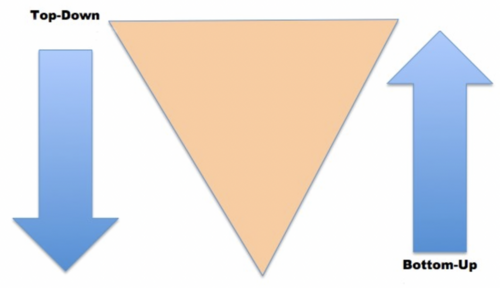
The big idea behind top-down and ground-up estimations is that they are two different approaches to estimating the size, scope, and cost or time of a project or initiative.
Top-down estimation involves starting with an overall estimate for the project and then breaking it down into smaller components [3]. This approach is often used in the start of a project when there is limited information available or when there is a need for a quick, high-level estimate. Top-down estimation can be useful for setting initial goals and identifying potential risks, but it may not provide a detailed understanding of the project's requirements and may not be accurate enough for budgeting and planning purposes. [4]
Ground-up estimations, on the other hand, involves breaking down the project into smaller, more manageable components and estimating the time, effort, and resources required for each of these components. Ground-up estimations are therefore often performed when the work breakdown structure has been performed. This approach is often used when there is more detailed information available about the project and when a more accurate estimate is needed. Ground-up estimation can be time-consuming, but it can provide a more accurate understanding of the project's requirements and can be useful for budgeting and planning purposes.
Both approaches have their advantages and disadvantages, and the choice of which to use will depend on the specific needs of the project and the available information. In some cases, a combination of top-down and bottom-up estimation may be used to provide a more comprehensive estimate.
Top-down estimations
Top-down estimating is a project management technique that involves estimating the total cost or duration of a project without using detailed information or analysis. It starts with evaluating a projects budget, duration or scope as a whole and then separating it into smaller components[5]. It is often used by company leadership and project managers. Used techniques often include estimation from experienced estimators and historical data from similar projects to make an educated guess of the overall cost or duration of the project [6]. The estimate is based on the information available at the start of the project, hence the tasks in the work breakdown structure are not clearly defined yet. In top-down estimations, the first step is for the project manager to identify the major deliverables or expenses that are required to complete the project. Then, using their experience or historical data, they estimate the total cost or duration of the project. The experienced estimators can be internally in the form of experienced managers and sometimes externally as outside experts. The top-down estimation priorities efficiency as it does not need middle management to provide detailed cost break downs, which allows managers to quickly asses potential opportunities, costs and durations. It can also be used for projects with a high degree of uncertainty or when a limited amount of information available. However, it is important to note that top-down estimating is less accurate than ground-up estimating, which involves estimating the cost or duration of each individual task in the project, thus top-down is used in the beginning of the project. As a result of the inaccuracy associated with top-down estimations techniques exist to assist in minimizing the error, here among analogous estimating . [4]
Ground-up estimations
Ground-up estimating or bottom-up estimating is a project estimation technique that involves breaking down the project into smaller, more manageable components, and estimating the effort, duration, or cost required for each of these components individually. These estimates are then aggregated to arrive at an overall estimate for the project [5]. An example of applying ground-up estimating could involve estimating the effort required to develop a new software application. The project could be broken down into smaller tasks, such as designing the user interface, coding the application, testing the application, and deploying the application. The effort required for each task would then be estimated individually, and the estimates would be aggregated to arrive at an overall estimate for the project. Based on the level of detail ground-up estimating is more accurate than top-down estimating because it provides a detailed breakdown of the project cost or duration. This makes it easier to identify specific areas where costs or timelines may need to be adjusted. Ground-up estimating is often used in later stages of a project when the level of detail required for a ground-up estimate is available.
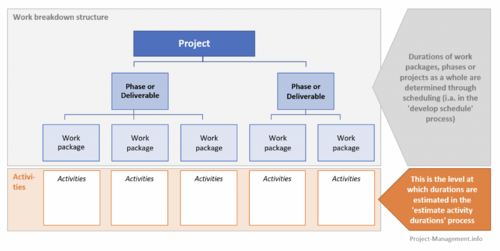
Some advantages of the ground-up approach includes:
- It provides a detailed estimate of the project, which can help to identify potential risks and dependencies.
- It allows for a more accurate estimate of the project, as each component is estimated individually based on its specific requirements and characteristics.
- It provides a transparent and verifiable estimate, as each component estimate can be validated and adjusted based on historical data or expert judgment.
However, as ground-up estimations sound accurate and efficient compared to top-down it also has its limitations including:
- It can be time-consuming and resource-intensive to estimate each component individually.
- It may not be appropriate for projects with a high level of uncertainty or complexity, as it may be difficult to estimate each component accurately.
- It may be difficult to communicate the estimate to stakeholders, as the level of detail may be overwhelming or difficult to understand.
In summary bottom-up estimating is a detailed project estimation technique that can provide a more accurate and transparent estimate of the project. However, it may not be appropriate for all projects and may require more time and resources than other estimation techniques such as top-down.
Estimation techniques and their application
In summary top-down is a high-level approach that is used when limited information is available whereas ground-up is a detailed approach where estimating the cost or duration of each work package at the lowest possible level, and then aggregating the estimates to produce a total cost or duration for the project. These approaches do not alone help in finding a sufficient or accurate estimate and multiple methods therefore exist in order to help estimations become as accurate as possible. Whereas, some methods are mainly made for top-down estimating and other ground-up estimating some can be applied at both levels.
Expert Judgement
Expert judgement is a commonly used method in project management for estimating activity durations and costs. It involves seeking input and guidance from individuals or teams with relevant experience and expertise to develop more accurate and reliable estimates. Expert judgement can be particularly useful in situations where historical data or other estimation methods are not available or reliable, or when there is a high degree of uncertainty or complexity involved in the activity being estimated. It can also help identify potential problems or risks that may impact the duration of an activity and develop contingency plans to address them.
Expert judgement can be in the form of project team members, stakeholders, industry experts, and consultants. It is important to seek input from a diverse range of experts to ensure a comprehensive and balanced perspective on the activity being estimated. Expert judgement can be applied or used in multiple ways and it is often seen both in top down and ground-up in the following ways:
- In the beginning of a project the estimations are often performed top-down due to the lack of team members and other estimation techniques might not be available due to the lack of data.
- With a ground-up approach having generated the deliverables for the WBS by asking those responsible for each work task about their estimates on resource requirements. This type of expert judgement can lead to very accurate results.
However, expert judgement does have limitations. It may be subject to bias or personal opinions, and the accuracy of the estimate depends on the expertise and experience of the individuals providing the judgement. Furthermore, it can be costly from hiring experts and if other methods such as the delphi/consensus method is applied it can also be time consuming as it becomes a repetitive process where experts must agree on the estimations. Anyhow, it has its advantages as it is a quick and efficient method that can be easily applied and does not require historical data.
Analogous Estimating
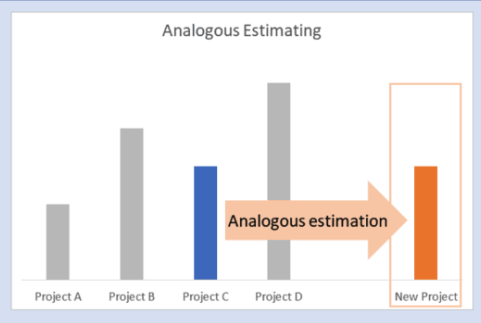
Analogous estimating is a top-down project management estimation technique that uses historical data or expert judgment [7] to estimate the parameters of a new project [8]. It is a top-down approach to estimating, as it relies on the assumption that the current project is similar in scope, complexity, and requirements to past projects, and that historical data can be used to derive estimates for the current project. An example of analogous estimating might involve estimating the cost of a new construction project based on the cost of a similar construction project completed in the past. The historical data would be used to identify the key cost drivers of the previous project, and these drivers would be applied to the current project to derive an estimate of its cost.
Some advantages of applying analogous estimating is:
- Quick and easy way to estimate the parameters of a new project, as it relies on historical data or expert judgment rather than a detailed analysis of the project requirements.
- It can provide a rough estimate of the project parameters early in the project lifecycle, which can be useful for budgeting and resource allocation purposes.
- It can be used in situations where there is limited information about the project requirements or where a detailed analysis of the requirements is not feasible.
However, this method also has its limitations in the form of:
- It may not be as accurate as other estimation techniques, such as bottom-up estimating or parametric modeling, which are based on a more detailed analysis of the specific requirements of the project.
- Not useful for projects that are significantly different from past projects, as the historical data will not be relevant or applicable.
- Relies heavily on the expertise of the estimator, which can introduce bias and subjectivity into the estimates.
Three-point Estimation
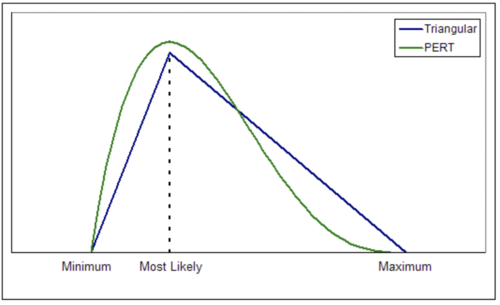
As known from the iron law of mega projects the larger a project the more likely it is to exceed budget, schedule and quality. From the iron law of mega projects Bent Flyvbjerg mentions “Nine out of ten such projects have cost overruns. Overruns of up to 50 percent in real terms are common, over 50 percent not uncommon”[10]. This is where three point estimating comes into the picture trying to prevent overruns from happening by estimating the duration or cost of a project or a task using three estimates: an optimistic estimate, a pessimistic estimate, and a most likely estimate. Thereby this estimation technique also includes the possibility of the project being over time, budget or quality. Even though this technique includes the pessimistic scenario it also includes an optimistic scenario which could balance the calculation to be closer to the anticipated most likely scenario [5]. This technique is mainly used after performing an estimate using one of the mentioned estimation techniques in this article.
- The optimistic estimate represents the best-case scenario for completing a task. It assumes that everything will go smoothly and that no unexpected issues will arise.
- The pessimistic estimate represents the worst-case scenario, assuming that everything that could go wrong will go wrong.
- The most likely estimate is the estimate that is based on the most realistic assessment of the task, taking into account the risks and uncertainties.
This technique is commonly used in project management to account for the uncertainties and risks associated with a project.
When performing a three point estimate, the project manager typically gathers input from experts, stakeholders, and team members who have experience with similar tasks. The final estimation of duration or cost can then be calculated in two different ways[6]:
- The triangular distribution, which calculates the average of the optimistic, pessimistic and most likely estimate. This is calculated in the following way where O=optimistic, P=pessimistic and M=most likely:

- The PERT distribution where a weighted average is calculated. The PERT distribution relies on the assumption that the probability of the most likely estimate is greater than the pessimistic and optimistic estimates and it is therefore assigned a four times larger value than the others. The PERT distribution is calculated the following way:

Important to be aware of when using the Three-point estimate is that it can be biased when finding the three scenarios, but this is also why this method tries to calculate an average of the distribution.
Parametric estimations
Parametric estimating is a method used in project management to estimate the duration of an activity based on statistical models and a set of parameters or variables [8]. It involves identifying the key variables that impact the duration of an activity and using historical data to develop statistical models or formulas to estimate future durations or costs [5]. This method is particularly useful for activities that are well-defined and have a high degree of standardization. By measuring the impact of different variables and assessing their interdependencies, project managers can develop more accurate and reliable estimates, reducing the risk of schedule overruns. Parametric estimating can also help identify potential problems or challenges that may impact the duration of an activity. An example of applying parametric estimating could be a construction company sector using a cost per square foot to estimate the cost of a building project. This method involves determining the average cost per square foot of similar construction projects in the same geographical area and using this information to estimate the cost of the project. If a construction company were to build a new building with a total floor area of 50,000 square feet. The company make use of historical data from similar projects in the same location to estimate the cost per square foot. If the average cost per square foot for similar projects is $200, then the estimated cost for the new office building would be:

An advantage of the parametric estimating is that it can be accurate for a project similar to a prior but it may not be effective for activities that are unique or have a high degree of variability, as the impact of different variables may be difficult to measure and predict. Additionally, the accuracy of parametric estimates depends on the quality and availability of historical data, which may be limited in some cases. This method is a mixture of top-down in the form of historical data combined with the increased accuracy from ground-up[3]. It can also be applied seperately when using top-down estimations where the overall cost or duration is calculated quickly from historical data as well as ground-up estimations where the parametric estimations are calculated for each work package.
Comparison of estimation techniques
To summarize the advantages and limitations of the estimation techniques a table has been made to create an overview of the differences of the techniques.
| |
Analogous Estimating |
Bottom-up Estimating |
Parametric Estimating |
Expert Judgment |
Three-Point Estimating |
|---|---|---|---|---|---|
| Input Data [6], [11] |
Data from previous comparable projects |
Activities & their scope of labour from the WBS |
Data from previous comparable projects |
Internal or external professionals' knowledge and experience |
Different techniques for estimating costs |
| Method |
Using data of past similar projects & adapting it |
Estimating costs at the lowest possible detail, then aggregating the different components |
Using data of past projects the present project's cost or duration per parameter unit. |
Experts provide estimates of the resources required to perform the job within the scope of the project, either from the top-down or from the bottom-up. |
An optimistic, pessimistic, and most likely estimate is by using one of the four other approaches and are then based on the Pert distribution or triangular converted into a weighted average value . |
| Output Type |
Total cost or duration of the project |
Total cost or duration of the project, as well as a cost of each activity |
Total cost or duration of the project, as well as a cost of each activity |
Varies from each project, but often times several outputs |
Final estimates of costs or duration, , standard deviation of estimates |
| Limitations | Risk of being inaccurate as a result of being a top-down estimations Mostly used in the beginning of a project. Bias can also be a limitation. |
Time consuming and it does not consider the ressources required for aggregating each activity |
Requires historical data which can be time consuming to gather and may not be available |
Can be expensive if external consultants are hired as well as time consuming. Furthermore, experts can be biased. | Time consuming to provide an estimate for all three scenarios. Can be biased when coming up with a most likely, pessimistic and optimistic scenario. |
Conclusion
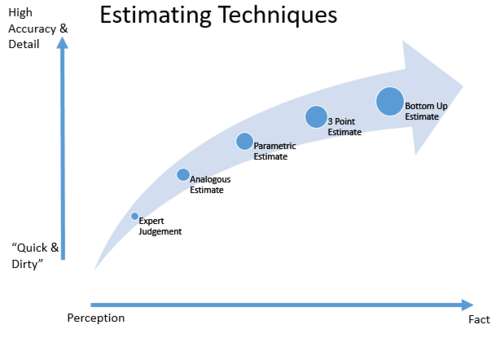
In summary, each estimation technique has its own advantages and disadvantages, but it can be challenging to determine the most efficient way to use them. It is important to note that each project is unique and there is no one-size-fits-all approach to estimating costs or durations. However, a best practice is to identify the project's scope and timeframe to decide between a top-down or ground-up approach. For example, a ground-up approach may be preferable for projects with a long time horizon, while a top-down approach may be more beneficial for projects with a tight timeline. Additionally, the amount of available information plays a significant role in selecting the appropriate estimation technique.
For construction projects with a vast amount of information available, the parametric estimation technique may be useful. This technique combines statistical data to provide a more accurate estimate of material costs and time duration. Alternatively, for entirely new projects with limited information, expert judgment may be the best approach, where external or internal experts use their experience to estimate costs or durations. For projects that are similar to previous ones but have limited information, analogous estimating may be useful, where assumptions about the new project are based on similarities with previous ones.
It is important to remember that estimation techniques are not infallible and unforeseen risks and challenges may arise during a project's lifetime. Therefore, it is recommended to use estimation techniques as a guideline rather than an exact science. Adjustments to estimations should be made as more information becomes available during the project. A combination of top-down and ground-up approaches can be beneficial, starting with an overall estimate and delving into more detail as more information is gathered.
In conclusion, the most accurate estimation techniques are ground-up, three point estimate, and parametric estimation. However, these techniques can be time-consuming, and therefore other techniques like analogous estimating and expert judgment can perform great under pressure. Ultimately, using estimation techniques carefully can help obtain a realistic and accurate estimate to avoid going over budget, past deadline, or compromising quality.
Annotated bibliography
B. Flyvbjerg - Estimating Cost of a Project: Techniques and Examples, Available online: https://towardsdatascience.com/the-iron-law-of-megaprojects-18b886590f0b This article provides the reader with important and interesting information about how and why mega projects tend to be unsuccessful by not being on time, within budget and quality. Furthermore, it is written by the highly respected Bent Flyvbjerg that has a large expertise within project management. It takes real life examples into considerations and discusses why they are a success and not. Moreover, this article can be valuable not only with regards to estimation techniques but understanding the larger picture of project management and its success criteria.
Project Management: "Managing Successful Projects with PRINCE2" 6th Edition (2017) Chapter 9.4 pp 116-118 This E-book provides a great and brief understanding of multiple estimation techniques here among the mentioned in this article and many more. The techniques are not described much in detail but it is a good source to create an overview of what different estimation techniques are, how they can be used and then google and research them individually.
(PMBOK Guide) Sebastian - Estimating Activity Durations: Definition, Methods, Practical Uses, Available online: https://project-management.info/estimating-activity-durations/. This article is great for gaining a more in depth understanding of the various estimation techniques and their application. Furthermore, it compares multiple methods and creates a detailed overview for the reader. This article has been key in the development of this article and it is therefore highly recommended to read the article as it has some valuable insights. Moreover, it is based on the knowledge from the PMBOK Guide but it provides the reader with a more practical understanding of the tools.
B. Flyvbjerg - Five things you should know about cost overrun, Available at: https://www.sciencedirect.com/science/article/abs/pii/S0965856418309157?via%3Dihub. This article provides the reader with a great understanding of why projects tend to have cost overruns. It is discussed and addressed that projects are overrun due to bias, behavior and scope change. This article is therefore not only interesting with regards to estimation techniques but also project management in general as it highlights some of the key points that should be considered when managing projects.
References
- ↑ B. Flyvbjerg - Five things you should know about cost overrun, Available at: https://www.sciencedirect.com/science/article/abs/pii/S0965856418309157?via%3Dihub
- ↑ Designing Buildings - Top down and bottom up estimating, Available online: https://www.designingbuildings.co.uk/wiki/Top_down_and_bottom_up_estimating
- ↑ 3.0 3.1 FreshBooks - Top-Down Estimating: Definition, Methods, Pros & Cons,” Available online: https://www.freshbooks.com/en-za/hub/estimates/top-down-estimating
- ↑ 4.0 4.1 S. Male - Understanding the Top-Down Estimating Technique,” Available online: https://www.runn.io/blog/top-down-estimating
- ↑ 5.0 5.1 5.2 5.3 Project Management: "Managing Successful Projects with PRINCE2" 6th Edition (2017) Chapter 9.4 pp 116-118,
- ↑ 6.0 6.1 6.2 6.3 (PMBOK Guide) Sebastian - Estimating Activity Durations: Definition, Methods, Practical Uses,” Available online: https://project-management.info/estimating-activity-durations/#6-expert-judgement
- ↑ 7.0 7.1 Analogous Estimating - Definition, Examples, Pros & Cons,” Available online:https://project-management.info/analogous-estimating/
- ↑ 8.0 8.1 Project Management: A guide to the Project Management Body of Knowledge (PMBOK guide), 7th Edition (2021) Chapter 4.4.2 Estimating pp 178
- ↑ S. Leleur - Researchgate - Triangular distribution vs. a PERT distribution,” Available online: https://www.researchgate.net/figure/Illustration-of-the-Triangular-distribution-vs-a-PERT-distribution- Vose-2006_fig6_224061457
- ↑ B. Flyvbjerg - Estimating Cost of a Project: Techniques and Examples,” Available online: https://towardsdatascience.com/the-iron-law-of-megaprojects-18b886590f0b
- ↑ (PMBOK Guide) Sebastian - Estimating Cost of a Project: Techniques and Examples,” Available online: https://project-management.info/estimating-project-cost/#8-expert-judgment-
- ↑ Methods of Cost Estimation in Projects – Tools and Techniques,” Available online: https://theconstructor.org/construction/methods-cost-estimation/36532/